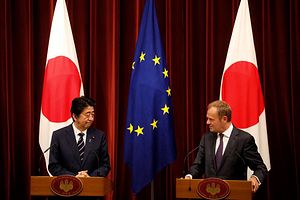On Tuesday, the European Union and Japan signed a free trade agreement—the EU-Japan Economic Partnership Agreement—the terms of which had been finalized in December 2017. The agreement eliminates tariffs on nearly all major goods traded between the two sides.
“The EU and Japan showed an undeterred determination to lead the world as flag-bearers for free trade,” Japanese Prime Minister Shinzo Abe said following the signing, alongside European Council President Donald Tusk and European Commission President Jean-Claude Juncker.
The agreement’s signing comes after both Japan and the EU—both U.S. allies—have faced heavy criticism from U.S. President Donald J. Trump for what he perceives as unfair trade practices. Recently, Trump described the 27-member EU as a “foe” for its trade practices.
Tusk underlined that the deal was the “largest bilateral trade deal ever.” Following China, Japan is the EU’s second largest trading partner by volume in Asia. The total EU economic are and Japan together account for around a quarter of global economic output.
The agreement’s signing this week was scheduled to take place earlier in Europe, but Abe had to cancel travel due to heavy flooding in southern Japan for unusually heavy rains, which claimed scores of lives.
Even as the three leaders separated the conclusion of the agreement, they did not draw attention to their respective tensions with the United States. Both Japan and the EU are subject to ongoing steel and aluminum tariffs implemented earlier this year by the United States.
According to the European Commission, the EU primarily imports machinery, electrical machinery, motor vehicles, optical and medical instruments, and chemicals from Japan. Japan, meanwhile, imports motor vehicles, machinery, pharmaceuticals, optical, and medical instruments, and electrical machinery from the EU.
In the bilateral goods trading relationship, Japan maintains a substantial surplus. In 2017, Japan ran a 8.4 billion euro surplus on trade in goods. In services, the EU maintains a substantial surplus. In 2017, the EU’s services trade surplus with Japan was 13 billion euros.
The free trade agreement signed on Tuesday will eliminate 99 percent of tariffs on Japanese imports by the European Union and 94 percent of tariffs on European imports by Japan. Eventually, Japan will bring the amount of lifted tariffs on European goods to cover 99 percent of all traded goods as well.
The two sides had been in talks over a free trade agreement for nearly five years. Last July, they reached an agreement in principle on the contours of the trade agreement.
For Japan, the conclusion of the agreement with Europe marks a major milestone. For Abe, the agreement is seen as a fillip to his ‘Abenomics’ set of monetary, fiscal, and structural policies.
While the EPA with the EU is Japan’s largest bilateral trade agreement, the country is the largest economy to participate in the Comprehensive and Progressive Trans-Pacific Partnership, a high standard-focused multilateral trade pact that succeeds the original twelve-member Trans-Pacific Partnership that the United States withdrew from last January.
Similarly, Japan is a participant in ongoing talks to conclude the Regional Comprehensive Economic Partnership between the ten member states of the Association of Southeast Asian Nations and other Asian states, including China and India.

































